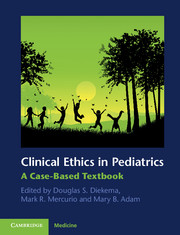Book contents
- Frontmatter
- Contents
- Contributors
- Preface
- Section 1 Core issues in clinical pediatric ethics
- Section 2 Ethical issues at the beginning of life: perinatology and neonatology
- Section 3 When a child dies: ethical issues at the end of life
- Section 4 Ethical issues posed by advances in medical technology and science
- Section 5 Children, public health, and justice
- 34 Resource allocation and triage in disasters and pandemics
- 35 Parental refusals of vaccination and school vaccine mandates: balancing parental freedom, child welfare, and public health
- 36 When institutional, professional, and public health obligations conflict: the controversial case of youth boxing
- Section 6 Special topics in pediatric ethics
- Index
- References
36 - When institutional, professional, and public health obligations conflict: the controversial case of youth boxing
from Section 5 - Children, public health, and justice
Published online by Cambridge University Press: 07 October 2011
- Frontmatter
- Contents
- Contributors
- Preface
- Section 1 Core issues in clinical pediatric ethics
- Section 2 Ethical issues at the beginning of life: perinatology and neonatology
- Section 3 When a child dies: ethical issues at the end of life
- Section 4 Ethical issues posed by advances in medical technology and science
- Section 5 Children, public health, and justice
- 34 Resource allocation and triage in disasters and pandemics
- 35 Parental refusals of vaccination and school vaccine mandates: balancing parental freedom, child welfare, and public health
- 36 When institutional, professional, and public health obligations conflict: the controversial case of youth boxing
- Section 6 Special topics in pediatric ethics
- Index
- References
Summary
Case narrative
A city police league asked a children’s hospital pediatrician to provide ringside medical supervision at a community amateur youth boxing event for at-risk urban boys. Amateur youth boxing is a legal sport performed in a controlled fashion with protective headgear. A licensed provider is required at the ringside in order for all boxing events to occur. The ringside physician provides pre-match assessments of the participants, monitors the boxing bouts, and has the authority to stop matches if they decide that doing so is in the participants’ best interests. The ringside physician may also prevent an individual from participating in future matches because of injury, illegal hits, or poor sportsmanship if deemed necessary. Neither professional boxing nor amateur martial arts events give such wide discretion to the ringside physician. Unlike professional boxing, the goal in amateur boxing is to score points rather than to “knock someone out.” The police league’s at-risk youth program upholds values such as diversity, equal opportunity, and self-confidence.
In the past, this pediatrician has provided assistance at other youth events sponsored by the police league, including football and soccer games. While checking her malpractice coverage to participate, she found herself mired in a larger controversy when several staff in her department expressed vehement opposition to her participation. The pediatrician’s colleagues cited the American Academy of Pediatrics (AAP) policy statement “vigorously opposing” youth boxing (Committee on Sports Medicine and Fitness, 1997). The AAP policy does not directly mention ringside assistance; however, the physician’s colleagues felt that participating in this program was inconsistent with the hospital’s commitment to injury prevention and programs designed to reduce concussions. Some individuals opined that boxing was nothing more than a “brutal sport” masquerading as “legalized violence,” and that the sport did not promote a healthy lifestyle.
- Type
- Chapter
- Information
- Clinical Ethics in PediatricsA Case-Based Textbook, pp. 211 - 214Publisher: Cambridge University PressPrint publication year: 2011



